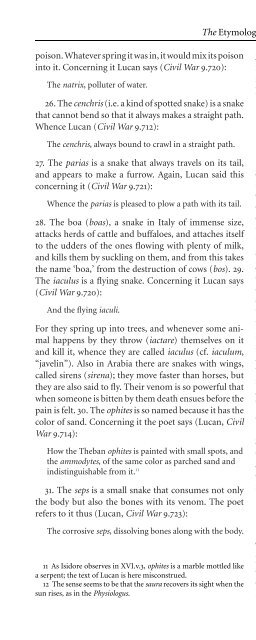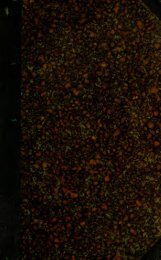The Etymologies of Isidore of Seville - Pot-pourri
The Etymologies of Isidore of Seville - Pot-pourri
The Etymologies of Isidore of Seville - Pot-pourri
Create successful ePaper yourself
Turn your PDF publications into a flip-book with our unique Google optimized e-Paper software.
poison. Whatever spring it was in, it would mix its poison<br />
into it. Concerning it Lucan says (Civil War 9.720):<br />
<strong>The</strong> natrix, polluter<strong>of</strong>water.<br />
26.<strong>The</strong>cenchris (i.e. a kind <strong>of</strong> spotted snake) is a snake<br />
that cannot bend so that it always makes a straight path.<br />
Whence Lucan (Civil War 9.712):<br />
<strong>The</strong> cenchris, always bound to crawl in a straight path.<br />
27. <strong>The</strong>parias is a snake that always travels onitstail,<br />
and appears to make a furrow. Again, Lucan said this<br />
concerning it (Civil War 9.721):<br />
Whence the parias is pleased to plow a path with its tail.<br />
28. <strong>The</strong>boa(boas), a snake in Italy <strong>of</strong> immense size,<br />
attacks herds <strong>of</strong> cattle and buffaloes, and attaches itself<br />
to the udders <strong>of</strong> the ones flowing with plenty <strong>of</strong> milk,<br />
and kills them by suckling on them, and from this takes<br />
the name ‘boa,’ from the destruction <strong>of</strong> cows (bos). 29.<br />
<strong>The</strong> iaculus is a flying snake. Concerning it Lucan says<br />
(Civil War 9.720):<br />
And the flying iaculi.<br />
For they spring upintotrees,andwheneversomeanimal<br />
happens by they throw (iactare) themselves on it<br />
and kill it, whence they are called iaculus (cf. iaculum,<br />
“javelin”). Also in Arabia there are snakes with wings,<br />
called sirens (sirena); they move faster than horses, but<br />
they are also said to fly. <strong>The</strong>ir venom is so powerful that<br />
when someone is bitten by them death ensues before the<br />
pain is felt. 30.<strong>The</strong>ophites is so named because it has the<br />
color <strong>of</strong> sand. Concerning it the poet says (Lucan, Civil<br />
War 9.714):<br />
How the <strong>The</strong>ban ophites is painted with small spots, and<br />
the ammodytes, <strong>of</strong>the same color as parched sand and<br />
indistinguishable from it. 11<br />
31. <strong>The</strong>seps is a small snake that consumes not only<br />
the body but also the bones with its venom. <strong>The</strong> poet<br />
refers to it thus (Lucan, Civil War 9.723):<br />
<strong>The</strong> corrosive seps, dissolving bones along with the body.<br />
11 As <strong>Isidore</strong> observes in XVI.v.3, ophites is a marble mottled like<br />
aserpent; the text <strong>of</strong> Lucan is here misconstrued.<br />
12 <strong>The</strong> sense seems to be that the saura recovers its sight when the<br />
sun rises, as in the Physiologus.<br />
<strong>The</strong> <strong>Etymologies</strong> XII.iv.26–iv.39 257<br />
32. <strong>The</strong>dipsas is said to be a snake so tiny that when it<br />
is stepped on it is not observed. Its venom kills before<br />
it is felt, so that the face <strong>of</strong> one about to die displays no<br />
horror <strong>of</strong> his impending death. Of this one the poet says<br />
(cf. Lucan, Civil War 9.737):<br />
With its head twisted back the dipsas, whenitwas<br />
stepped on, bit the young standard-bearer Aulus, <strong>of</strong><br />
Tyrrhenian blood; there was barely any pain or sensation<br />
<strong>of</strong> fangs.<br />
33. <strong>The</strong>salpuga is a snake that is invisible. <strong>The</strong> caecula<br />
is so named because it is small (i.e. has the diminutive<br />
ending –ula) andhas no eyes (cf. caecus, “blind”). <strong>The</strong><br />
centipede (centupeda)issonamedforthegreat number<br />
<strong>of</strong> its feet (pes, gen.pedis). 34. <strong>The</strong> lizard (lacertus) isa<br />
type <strong>of</strong> reptile, so named because it has arms (cf. lacertus,<br />
“upper arm”). <strong>The</strong>re are many kinds <strong>of</strong> lizards, such<br />
as the botrax, the salamander, the saura, andthe newt.<br />
35. <strong>The</strong>botrax is so named because it has the face <strong>of</strong><br />
afrog,fortheGreeks call the frog . 36. <strong>The</strong><br />
salamander (salamandra)issonamed because it prevails<br />
against fire. Of all the venomous creatures its force is<br />
the greatest; the others kill people one at a time, but<br />
the salamander can slay many people at once – for if<br />
it should creep in among the trees, it injects its venom<br />
into all the fruit, and so it kills whoever eats the fruit.<br />
Again, if it falls into a well, the force <strong>of</strong> its venom kills<br />
whoever drinks from it. This animal fights back against<br />
fire; it alone <strong>of</strong> all the animals will extinguish fire, for it<br />
can live in the midst <strong>of</strong> flames without feeling pain or<br />
being consumed – not only because it is not burned but<br />
also because it extinguishes the fire.<br />
37. <strong>The</strong>saura is a lizard whose eyes go blind as it<br />
grows old. It goes into a chink in an east-facing wall,<br />
and stretches out and receives light when the sun rises. 12<br />
38.<strong>The</strong>newt (stellio) has its name given according to its<br />
color, for on its back it is marked with glittering spots<br />
in the manner <strong>of</strong> stars (stella). Ovid says concerning it<br />
(Met. 5.460):<br />
It has a name appropriate for its color, star-strewn<br />
(stellatus) with variegated spots on its body.<br />
This animal is considered to be the antagonist <strong>of</strong> scorpions,<br />
so that when it is seen by them it induces fear<br />
and stupefaction. 39. <strong>The</strong>reare other kinds <strong>of</strong> snakes,<br />
such as the ammodyta, the elephantia, the chamaedraco.<br />
Finally, there are as many deaths caused by snakes as

















